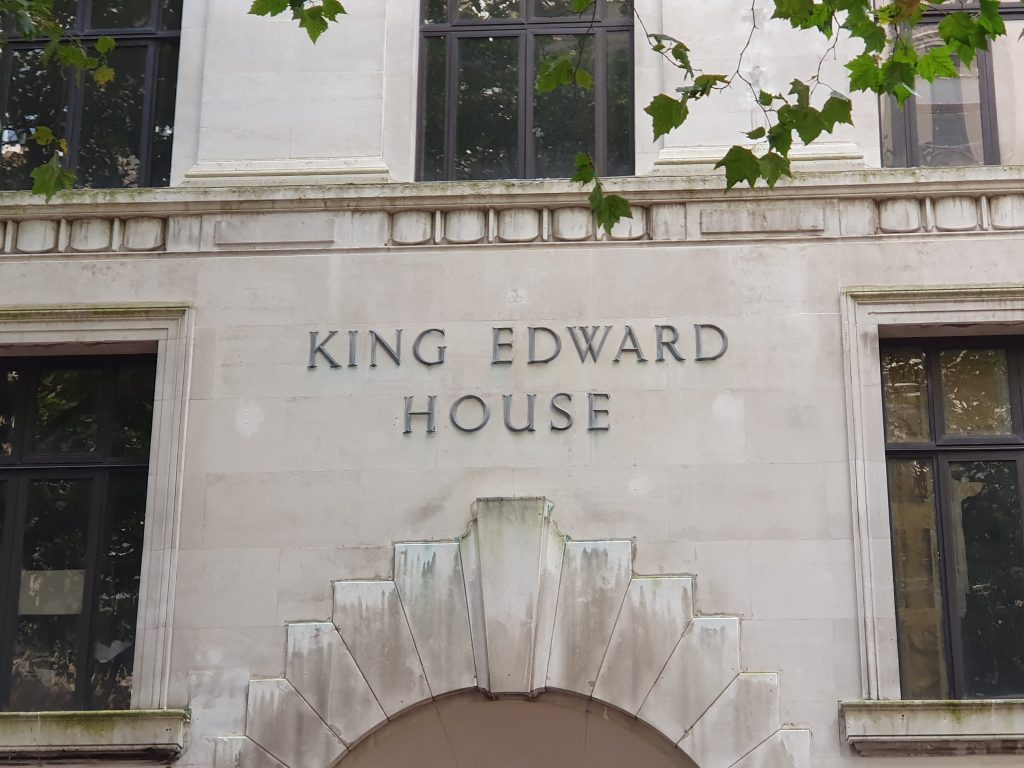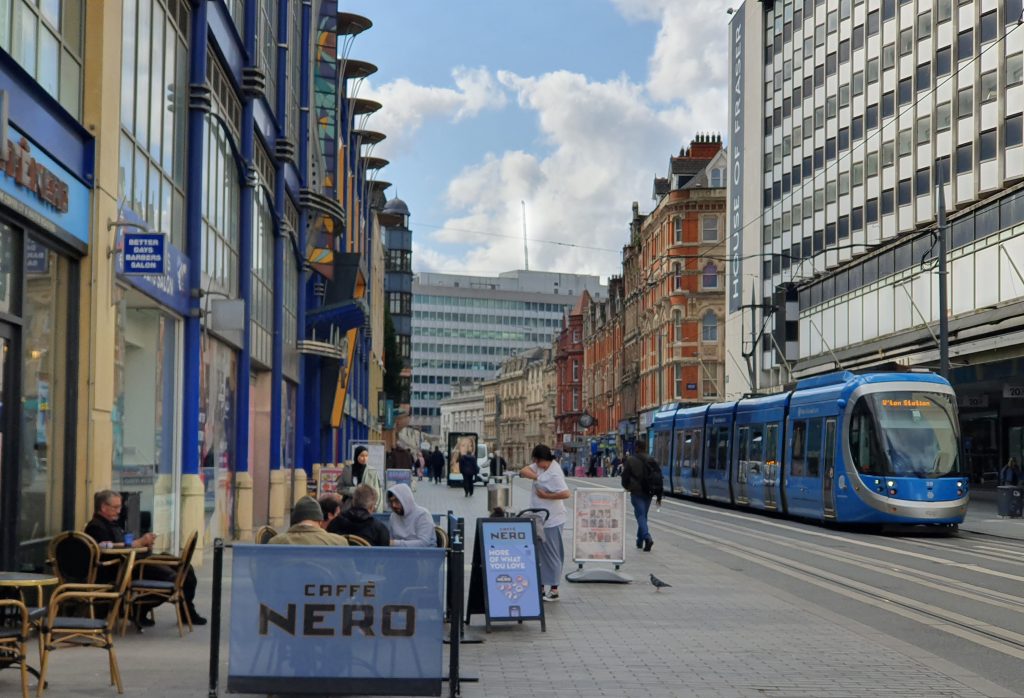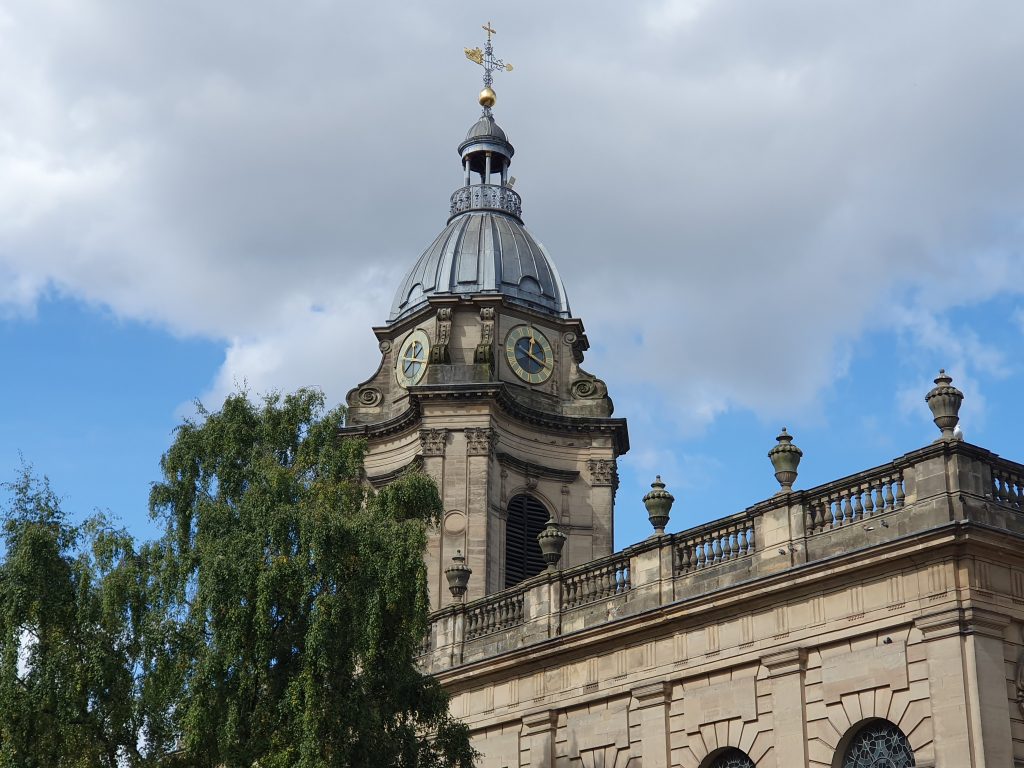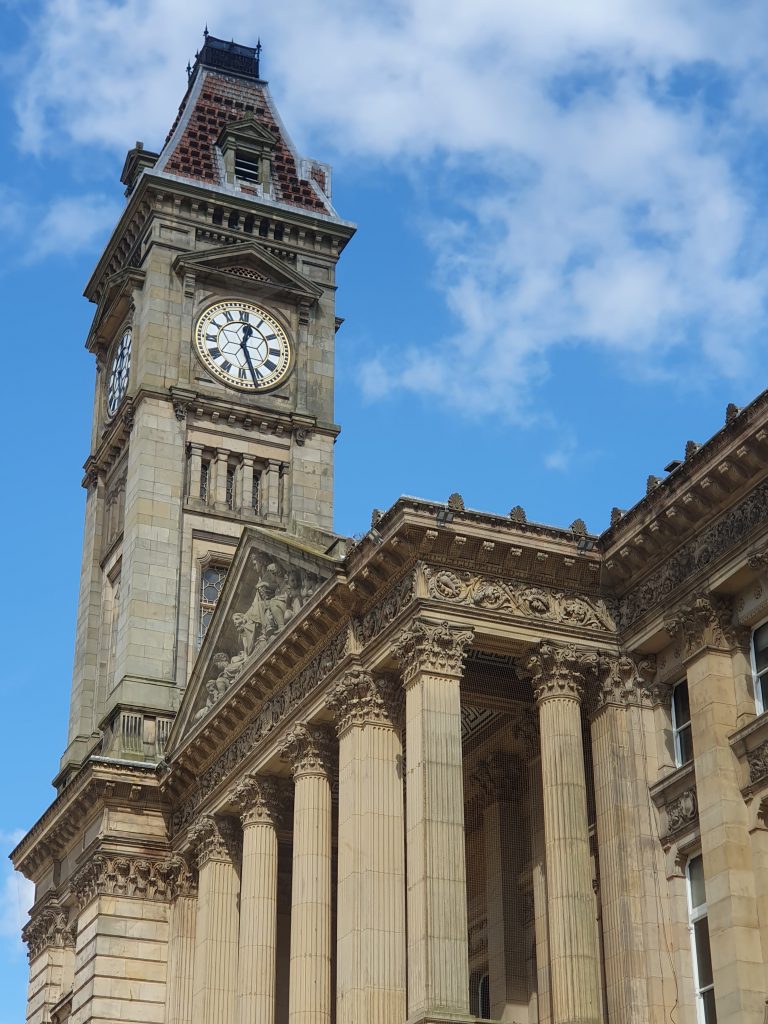Distance: 2.3 miles / 3.7 kilometres
Total ascent: 135 feet / 41 metres
Walking time: 45 minutes to 1 hour
Every site of interest along this alternative section of The Shire Way relates to the lives of J.R.R. Tolkien, his ancestors and his relations. As you will see, many of the original buildings have been destroyed and you will need to use all your imaginative faculties to picture a more vernacular, pre-1960s Birmingham. Nevertheless, this is Tolkien’s ‘home town’. A century of religious, commercial, political, educational and recreational interactions, which took place within this square mile of city streets, formed the background from which his art emerged.
The alternative start to The Shire Way begins at New Street railway station in the centre of Birmingham.
The station was once the site of Prince Street, where Tolkien’s great-great-grandfather William Suffield (c. 1777-1847) ran a printshop in the early 1810s, shortly after relocating his wife and (approximately) nine children from Evesham in Worcestershire. He seems mostly to have published non-conformist Christian books and pamphlets.
Over seventy-five years later (in around 1888), it was in New Street station that sixteen-year-old Jennie Suffield acted as go-between for her elder sister (Tolkien’s mother) by transmitting love-letters to and from Arthur Tolkien. J.R.R. Tolkien’s grandfather, John Suffield, was not enthusiastic about a match between his daughter Mabel, then eighteen, and the thirty-one-year-old bank clerk, and the couple would have to wait until April 1891 to marry. Jennie (or Emily Jane) Suffield, later the aunt of J.R.R. Tolkien who owned Bag End farm, would have been able to act as intermediary because she travelled by train from Moseley into Birmingham to attend the King Edward’s High School for Girls, which was at that time on Congreve Street (now Congreve Passage).
From the main concourse of the station, follow the exit signs for Stephenson Street, Navigation Street or ‘towards Victoria Square’.
Having emerged from the station, look to your left. Around 50 metres away, beyond the mini-roundabout and on the north side of Navigation Street, is the former site of a tram-stop which Tolkien would have used to reach the King Edward’s School rugby pitches in south Edgbaston. In a letter of 1944, Tolkien mentions making the journey again ‘from the same old corner at which I used to catch [the tram] to go out to the playing fields’, in order to reach a reunion at the school’s new campus.
Turn right onto Stephenson Street and continue in that direction for 100 metres, at which point the road becomes Stephenson Place and bends to the left. Walk uphill for 50 metres to New Street.
You will see in front of you, at a distance of about 650 metres, the red-brick and terracotta tower of Methodist Central Hall. Its construction in 1903-4 was overseen by Dr F.L. Wiseman, first Superintendent of the Birmingham Mission (1888-1913), who was also the father of Tolkien’s closest school-friend, Christopher Wiseman.
Turn right onto New Street and walk 70 metres.
On your right is King Edward House (131-138 New Street), the building now occupying the site of King Edward’s School, which Tolkien attended (with an eight-month interval) from September 1900 until July 1911. Mabel Tolkien was eager to enrol her son there at the earliest possible age, despite the requisite entrance and tuition fees. Not only did the institution enjoy a national reputation as alma mater to the artist Edward Burne-Jones, Edward White Benson (the Archbishop of Canterbury, 1883-1896) and some of the age’s finest scholars of Ancient Greek, but it had educated Mabel’s husband, his younger brother, her elder brother and one of her cousins; her younger sister had attended the High School for Girls. Tolkien’s own younger brother was also a pupil at King Edward’s from 1905 until 1910.

When Tolkien said in an interview that King Edward’s was ‘ultimately of medieval foundation’, he was not entirely correct, for a religious guild was granted a royal charter to set up the school in 1552. The buildings nevertheless looked medieval, having been built in a neo-gothic style by Charles Barry and Augustus Pugin, who would go on to design the Houses of Parliament. Completed in 1838, this iteration of the school consisted of two enclosed two courtyards. The head master lived in one wing, in the opposite wing the second master; both with views of New Street via two-storey oriel windows. In between was ‘Big School’, the great hall where eight or nine classes might be in session at any one time. Tolkien remembered with ‘deepest affection… the magnificent old buildings, so inconvenient but so educative’.
It was at King Edward’s that Tolkien developed his interest in ancient languages. From the age of thirteen he taught himself Old English (‘when supposed to be learning Greek and Latin’) and from eighteen Gothic. He was prominent in the Debating and Literary Societies; he acted in modern and classical plays; he joined the Combined Cadet Force; and he played various sports, particularly rugby. In later years, after K.E.S. had been demolished in 1936 and relocated to Edgbaston, Tolkien said that he remember the school ‘with deepest affection (and gratitude); though memory is also painful… On the very rare occasions on which I either walk down New Street, or come within sight of the Bristol Road Ground, I am filled with melancholy (not unmixed with anger).’ He had already described one such visit in a letter to his son Christopher:

As you look further down New Street, the ‘patch of ghastly wreckage’ must have been on your left. In this vicinity was the jeweller’s store E.H. Lawley & Sons, where Tolkien and Edith Bratt met in January 1910, contrary to his guardian’s wishes and instructions. They bought each other presents, a fountain pen and a watch, to celebrate their eighteenth and twenty-first birthdays respectively.
Continue eastwards along New Street for 120 metres. Near the foot of the Rotunda (the cylindrical 1960s tower on your right), with the steeple of St Martin’s Church visible ahead, turn left onto the High Street. Walk along the High Street for 130 metres to the junction with Carrs Lane.
The junction of the High Street and Carrs Lane was the point at which a Chartist demonstration of 4th July 1839 turned violent. Tolkien’s grandfather, then six years old, was caught up in the ensuing riot and his recollections were published by local newspapers in 1908 and 1928, apparently influencing Tolkien’s description of the ‘Battle of Bywater’. Just as the Chartists (‘every man armed with stick or knife’) marched towards Holloway Head between the shopfronts of the High Street, and found themselves confronted at Carrs Lane by a cordon of special constables (‘armed with stout staves’), so the ‘ruffians’ in The Lord of the Rings are caught between the high banks of the Bywater Road by hobbits likewise armed with ‘stout staves’. Neither the ruffians nor the Chartists were willing to lay down their knives and clubs, with sanguinary consequences.
Walk another 50 metres northwards along the High Street, almost to the point where the road divides into Dale End (on the right) and Bull Street (on the left).
On your left is 81 High Street and the loading bay for the shops on Martineau Place. This was formerly the site of ‘Old Lamb House’ (106-109 Bull Street), the sixteenth-century building from which Tolkien’s great-great-grandfather ran a printshop during the 1820s, serving noteworthy customers like Matthew Boulton (jr.) and John Cadbury. It was also the premises where Tolkien’s great-grandfather set up the Suffield drapery business in 1826 and where his grandfather was born in 1833. The entrance to Crooked Lane, where the family also had a warehouse, was immediately to the left of Old Lamb House. The Suffield shop was forced to close and relocate in around 1884 as the area had been designated for clearance as part of Joseph Chamberlain’s ‘Improvement Scheme’. Old Lamb House was pulled down in 1886.
Turn left onto Bull Street and walk 100 metres up to the junction with Corporation Street.
On your left was the site of Barrow’s Stores, the department store where Tolkien and his fellow school librarians began to hold their gatherings in the summer of 1911 and which subsequently lent its name to a smaller artistic coterie of Tolkien, Christopher Wiseman, R. Q. Gilson (1893-1916) and G. B. Smith (1894-1916): The Tea Club and Barrovian Society (or T.C.B.S. for short). Their favoured meeting place in the oak-panelled café was a table in a secluded alcove which they called ‘The Railway Carriage’.

Turn left and walk south-westwards along Corporation Street for 130 metres.
On your right is 39 Corporation Street, where the Suffield drapery business reopened after leaving Old Lamb House. Unfortunately, the business was bankrupted by an accident in around 1890, when some sprinklers were activated during the course of a night, ruining the entire stock.
Continue for a further 40 metres down Corporation Street and then turn right onto Fore Street, coming very shortly to Cannon Street.
The Baptist Chapel in which Tolkien’s maternal grandfather was christened in 1833 was located on your left as you look down Cannon Street.
Turn right onto Cannon Street and then almost immediately (after 20 metres) left up New Cannon Passage. Continue for 60 metres as the passage joins Needless Alley and then meets Temple Row. Cross straight over Temple Row and enter Cathedral Square so as to approach the cathedral church.
In 1842, Tolkien’s grandfather John Suffield was (like his younger siblings) re-christened at the Anglican St Philip’s Church.

From St Philip’s Cathedral, turn south-westwards and leave the square via the gate opposite The Ivy restaurant. Cross over Temple Row and walk down Temple Street for 150 metres, which brings you back to New Street. From this point on, you’ll mostly follow Tolkien’s route home from school. Turn right onto New Street and walk 150 metres westwards and gently uphill.
Further up the street and on your right is 70 New Street, where the author’s grandfather John Benjamin Tolkien (1807-1896) leased a shop between 1848 until 1870, selling music and musical instruments, particularly pianofortes. He had relocated his family from London five years previously, probably because he identified a growing market in Birmingham for such wares. Thanks to the Triennial Festival, which (from 1834 onwards) took place annually in the nearby Town Hall, the town had a burgeoning reputation as a centre of musical activity. Felix Mendelssohn was commissioned to write and perform his Second Piano Concerto for the 1837 festival and he performed there again in 1840 and 1846. Perhaps as a consequence, the demand in Birmingham for pianos, sheet music and lessons grew and John’s business thrived.
The shop changed premises in 1870, moving the short distance to 87 New Street, on your left. However, it suffered badly during the depression of the 1870s and, in 1877, the firm went bankrupt. J.R.R. Tolkien said of his paternal grandfather: ‘He was once a wealthy man, but not one of business and a rigidly religious Baptist and would not deal with music halls or theatres. He was a dear old and poor man in the nineties when I knew him.’
Continue for 120 metres and cross Victoria Square to its north-west corner, passing the statue of Queen Victoria and the ‘Iron:Man’ sculpture.
On your left is Birmingham Town Hall, designed in 1831 by Edward Welch and Joseph Hansom to emulate the appearance of the Temple of Castor and Pollux in ancient Rome. For Tolkien and Christopher Wiseman, the building was a prominent feature on their daily walks to and from school. It was perhaps one reason why they referred to themselves as the ‘great twin brethren’, an allusion to Castor and Pollux in T.B. Macaulay’s poem ‘The Battle of Lake Regillus’.
On your right is Birmingham Council House. Its construction (completed in 1879) entailed the elimination of the corner where Ann Street and Congreve Street met and where you are now standing. Here stood a castellated building known as ‘The Flag’, which housed a Cabinet of Curiosities in the early nineteenth century. By the 1830s it had become a chemist’s and grocer’s store run by Tolkien’s great-great-uncle, Samuel Wilson Suffield (1796-1875).

Continue towards the clocktower and enter Chamberlain Square.
The clock tower of the Council House, ahead on your right, was built in 1885 and is known locally as ‘Big Brum’. It was probably its bell to which Tolkien referred in one letter to his wife, Edith. In it, he recalled that, when they had been orphans living in a boarding house one mile to the south-west in Edgbaston, they used to lean out of their bedroom windows at night to talk to each other and even watch ‘the sun come up over town through the mist and Big Ben toll hour after hour’.

Walk past the fountain to the north-west corner of Chamberlain Square. Climb the steps and then turn left, in the direction of Centenary Square.
You are now walking across the site of Mason Science College, the predecessor institution of Birmingham University. Here, Jennie Suffield (Tolkien’s aunt) became, in around 1890, the first school-girl to receive extra physiology tuition. Efforts were made to shield her from the male students and, if any interrupted her classes, Jennie was obliged to leave via a back staircase. The impressive neo-gothic building was demolished in 1964 to make way for the brutalist Central Library, itself torn down in 2013.
Continue westwards for 150 metres as Chamberlain Square becomes Centenary Way, which in turn crosses Lyon Queensway and brings you to Centenary Square.
Straight ahead of you is The Hall of Memory, a monument to the 12,320 Birmingham citizens killed in the Great War. It was built between 1922 and 1925 by the father of Tolkien’s school-friend T.K. (or ‘Teacake’) Barnsley, killed in action near Ypres in July 1917.

Walk the length of Centenary Square to its far-left corner, where there is a golden monument to the inventors of the steam engine and pioneers of the Industrial Revolution, Matthew Boulton, James Watt and William Murdoch.
On your right is the International Convention Centre, site of The Prince of Wales Theatre, where Tolkien met and spoke to Edith against his guardian’s wishes on 16th February 1910, shortly before her departure for her new home in Cheltenham. A couple of months later, he saw an ‘unforgettable’ production of Peter Pan at the same theatre and wished she had been there.

Proceed in the same south-westerly direction along Broad Street for 350 metres.
Just before you reach the hotel, look up the passage on your right, in the direction of Brunswick Street. This was the site of an iron foundry where Tolkien’s maternal grandfather worked in the early 1890s, following the collapse of the Suffield family’s drapery business.
Continue along Broad Street for a further 450 metres. Here we deviate slightly from Tolkien’s usual route home from school. Use the underpass to cross the A4540, which joins the Five Ways roundabout from the right, and emerge onto the A456 Hagley Road. Walk along the north (righthand) side of the Hagley Road for 180 metres.
The corner of the Hagley Road and Francis Road is the place where Tolkien last glimpsed Edith before she left for Cheltenham. He wrote disconsolately in his diary: ‘At Francis Road corner she passed me on bike on way to station. I shall not see her again perhaps for three years.’
Continue along the Hagley Road for a further 50 metres and then use the crossing. Having reached the south side of the Hagley Road, turn left and proceed in that direction for 60 metres. Upon reaching the entrance of Morrisons’ supermarket, turn right and use the passageway to reach Harborne Road 80 metres beyond. Once there, you are back on the daily route used by Tolkien and Wiseman. Turn right and walk 120 metres to the junction with Greenfield Crescent. From this point on, the directions for The Shire Way are the same as for Leg 1A.
NEXT: Leg 1A of The Shire Way